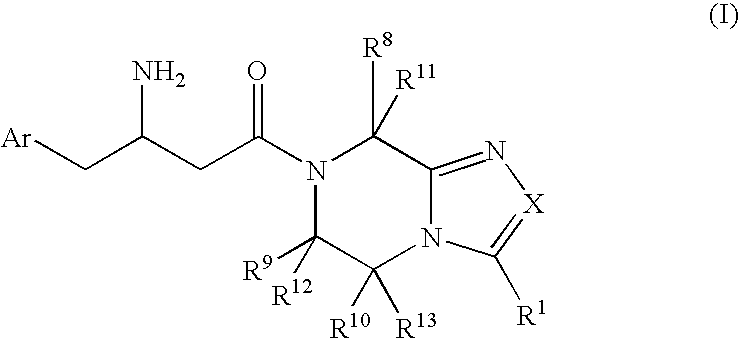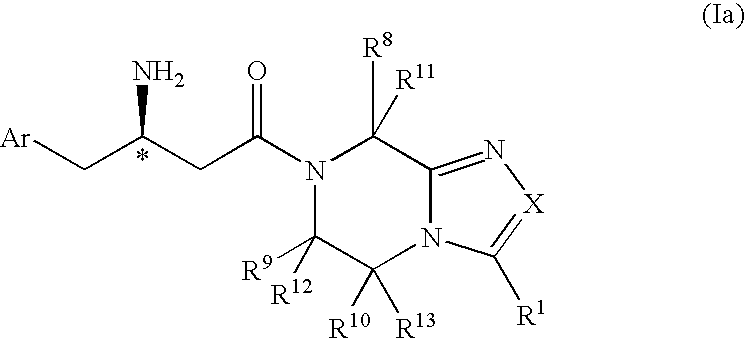3-Amino-4-phenylbutanoic acid derivatives as dipeptidyl peptidase inhibitors for the treatment or prevention of diabetes
a technology of dipeptide inhibitors and phenylbutanoic acid, which is applied in the direction of biocide, drug composition, metabolic disorder, etc., can solve the problems of increased and premature morbidity and mortality, increased risk of macrovascular and microvascular complications in patients with type 2 diabetes mellitus, and increased risk of macrovascular and microvascular complications in patients
- Summary
- Abstract
- Description
- Claims
- Application Information
AI Technical Summary
Benefits of technology
Problems solved by technology
Method used
Image
Examples
example 1
[0341]
Ethyl 7-[(3R)-3-amino-4-(2,5-difluorophenyl)butanoyl]-5,6,7,8-tetrahydroimidazo[1,2-a]pyrazine-2-carboxylic acid, trifluoroacetic acid salt
Step A: Ethyl imidazo[1,2-a]pyrazine-2-carboxylate
[0342] To a solution of 2-aminopyrazine (1.0 g, 10.5 mmol) in dioxane (25 mL) was added ethyl 3-bromo-2-ketopropionate (2.0 g, 10.5 mmol). The reaction was stirred at 50° C. for 16 h. The mixture was filtered and the solid was washed with two portions of ethyl acetate. The solid was heated in 35 mL of isopropanol at reflux temperature for 4 h. The reaction mixture was concentrated and partitioned between ethyl acetate and saturated aqueous sodium bicarbonate. The aqueous phase was extracted with three portions of ethyl acetate. The combined organics were washed with brine, dried over magnesium sulfate, and concentrated. Purification by chromatography (Biotage system, silica gel, ethyl acetate then 10% methanol / ethyl acetate) gave the title compound as a solid.
Step B: Ethel 5,6,7,8-tetrahy...
example 2
[0346]
7-[(3R)-3-Amino-4-(2,5-difluorophenyl)butanoyl]-5,6,7,8-tetrahydroimidazo[1,2-a]pyrazine-2-carboxylic acid, trifluoroacetic acid salt
[0347] To a solution of 165 mg (0.335 mmol) of ethyl 7-[(3R)-3-[(tert-butoxycarbonyl)amino]4-(2,5-difluorophenyl)butanoyl2-5,6,7,8-tetrahydroimidazo[1,2-a]pyrazine-2-carboxylate (Example 1, Step C) in 2 mL of tetrahydrofuran and 2 mL of water was added lithium hydroxide (24 mg, 1.01 mmol). The reaction mixture was stirred at ambient temperature for 14 h. It was then concentrated and partitioned between ethyl acetate and 2N aqueous hydrochloric acid. The aqueous phase was washed sequentially with three portions of ethyl acetate. Concentration of the aqueous phase provided the title compound, which was purified by HPLC (YMC Pro-C18 column, gradient elution, 5-95% acetonitrile / water with 0.1% TFA) to give the title compound. LCIMS 365 (M+1).
example 3
[0348]
7-[(3R)-3-Amino-4-(2,5-difluorophenyl)butanoyl]-N,N-dimethyl-5,6,7,8-tetrahydroimidazo[1,2-a]pyrazine-2-carboxamide, dihydrochloride
Step A: 7-[(3R)-3-[(tert-Butoxycarbonyl)amino]-4-(2,5-difluorophenyl)butanoyl]-5,6,7,8-tetrahydroimidazo[1,2-a]pyrazine-2-carboxylic acid
[0349] To a solution of 295 mg (0.6 mmol) of ethyl 7-[(3R)-3-[(tert-butoxycarbonyl)amino]-4-(2,5-difluorophenyl)butanoyl]-5,6,7,8-tetrahydroimidazo[1,2-a]pyrazine-2-carboxylate (Example 1, Step C) in 4 mL of tetrahydrofuran and 4 mL of water was added 57.7 mg (2.4 mmol) of lithium hydroxide. The mixture was stirred at ambient temperature for 14 h. It was then concentrated to a volume of approximately 4 mL. Acetic acid (0.173 mL) was added and the mixture was extracted sequentially with three portions of ethyl acetate. The combined organic phase was washed with brine, dried over magnesium sulfate, and concentrated to provide the title compound as a white solid.
Step B: N,N-Dimethyl-7-[(3R)-3-[(tert-butoxycarbony...
PUM
| Property | Measurement | Unit |
|---|---|---|
| Pharmaceutically acceptable | aaaaa | aaaaa |
Abstract
Description
Claims
Application Information
 Login to View More
Login to View More - R&D
- Intellectual Property
- Life Sciences
- Materials
- Tech Scout
- Unparalleled Data Quality
- Higher Quality Content
- 60% Fewer Hallucinations
Browse by: Latest US Patents, China's latest patents, Technical Efficacy Thesaurus, Application Domain, Technology Topic, Popular Technical Reports.
© 2025 PatSnap. All rights reserved.Legal|Privacy policy|Modern Slavery Act Transparency Statement|Sitemap|About US| Contact US: help@patsnap.com



